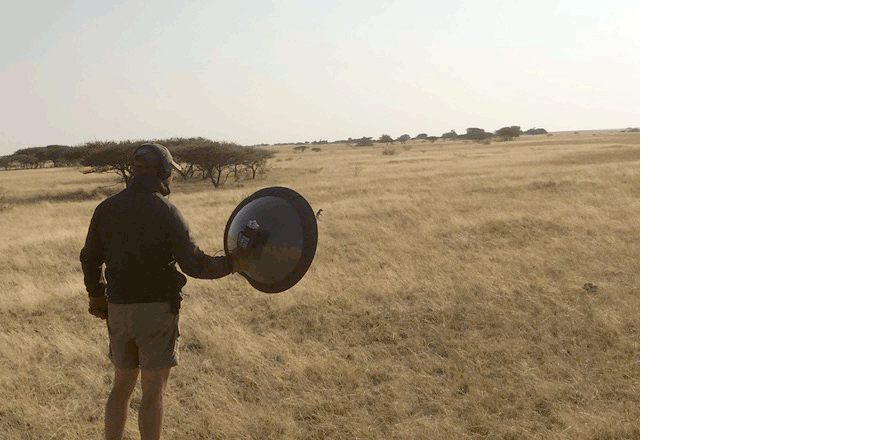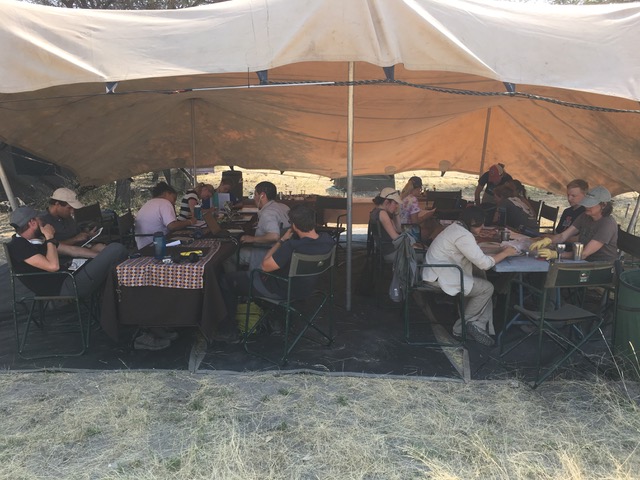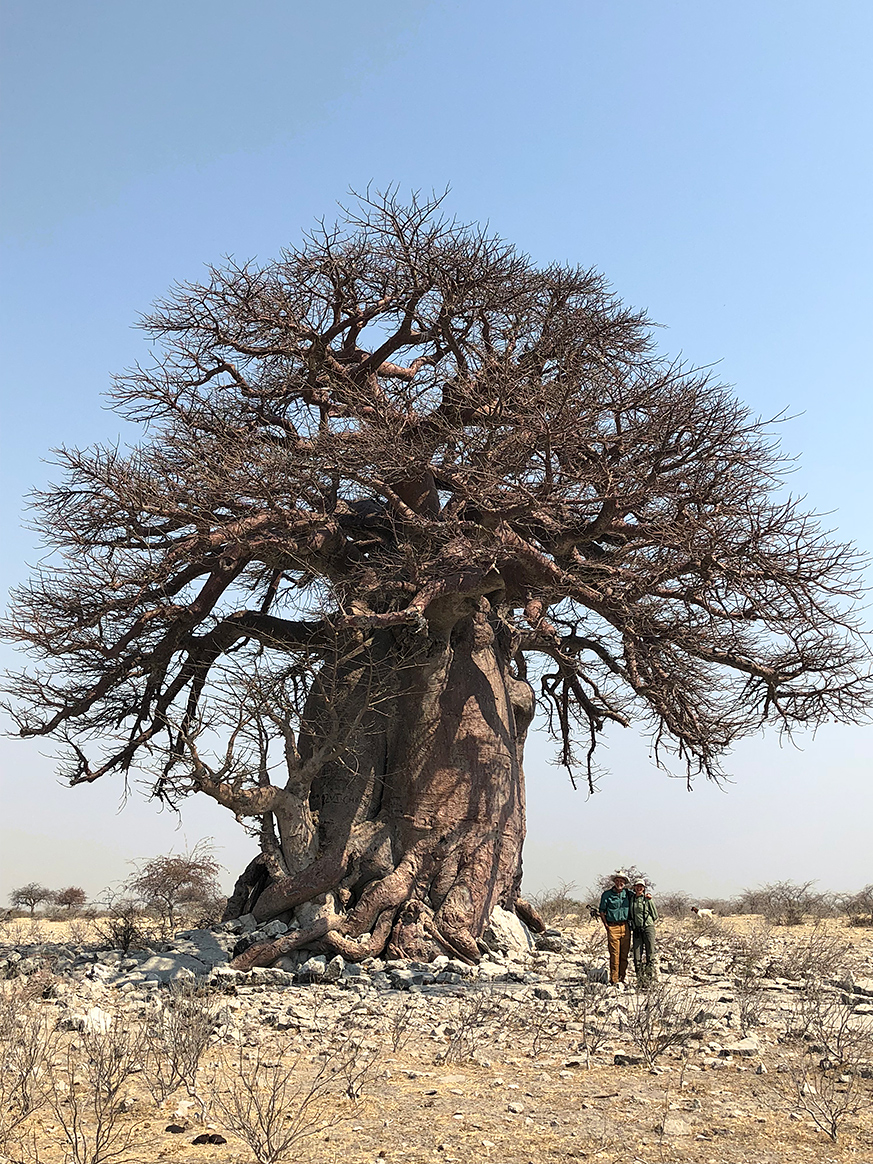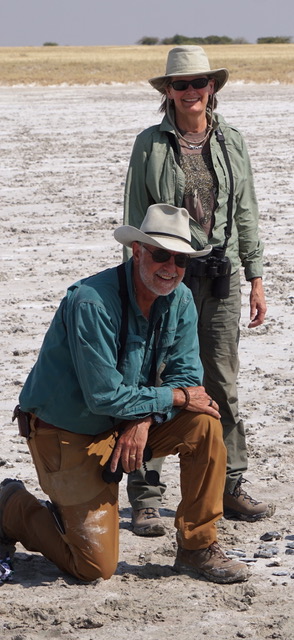Notes from the Field: Tony Barnosky and Liz Hadly - Last Day at Makgadikgadi Pan

The last day of field work is often bittersweet for us, blending the lingering excitement of new discoveries with a tinge of regret that comes from knowing that in just a couple of days, the splash of the Milky Way across the Southern Cross will no longer be our bedtime ceiling, and our morning wake-up will be the beep of a clock instead of a jackal calling out in the predawn stillness.
That was our mood at first light as we headed out towards the ‘pan’—back home we’d call this a dry playa lake—to check up on the meerkat colony. Finding them took longer than yesterday, since the same gusty wind that chilled us in the open Land Rover kept them snuggling in their warren for nearly an hour after the first rays of the sun hit their burrows. But eventually Liz spotted them, popping up one by one in rapid succession, showing off their perfect posture and turning their deceivingly primate-like faces towards us to get a good look before dropping to all fours,black-tipped tails straight up in the air and making a beeline for a hollow more sheltered from the wind. Once there the foraging began. Now on foot, we followed them to observe both their feeding behavior and vocalizations—the former with eyes, binoculars, and cameras, the latter with a hand-held parabola acoustic monitor. Squeals of delight began to erupt from the meerkats (and mentally from us as well although we needed to keep quiet) as the alpha male raided a barking-gecko hideaway and took a couple of tender young lizards to the juveniles, who excitedly crunched them down in short order, just as they do with the numerous scorpions in the area.
 That was the feeling of discovery, then came the feeling of accomplishment, as back at camp, graduate and undergraduate students and instructors collaborated to synthesize what they’d learned over the time we had been living in this African landscape. The weeks on the road and in camp had shown us the best and worst of what the Anthropocene can become, and awakened new ways of looking at the world in the young minds that accompanied us. For all of us, students and faculty alike, traveling through this special landscape with some of those who call it home had deepened our appreciation for Botswana's potentials and pitfalls, which reflect problems and solutions that also play out on the global stage.
That was the feeling of discovery, then came the feeling of accomplishment, as back at camp, graduate and undergraduate students and instructors collaborated to synthesize what they’d learned over the time we had been living in this African landscape. The weeks on the road and in camp had shown us the best and worst of what the Anthropocene can become, and awakened new ways of looking at the world in the young minds that accompanied us. For all of us, students and faculty alike, traveling through this special landscape with some of those who call it home had deepened our appreciation for Botswana's potentials and pitfalls, which reflect problems and solutions that also play out on the global stage.
And then, the tinge of regret that this year’s journey was coming to an end. In the evening a few of us went back to the pan to experience that special African sunset one more time. The sky was colored orange, the sun even more so by the dust hanging in the air, and sky and sun merged like our contrasting emotions into the muted white lake bed. The only sound was our feet crunching through the salty crust, sending up puffs of dust that floated away like our thoughts as we ambled along.
By the time the sky had faded into black and once again sparkled with the constellations of the southern sky, we were back in camp for the last set of fireside learning sessions, with students projecting their data on a bed sheet stretched across the Land Rover. Reluctant to see it all come to an end, once the sheet came down we piled into the Land Rover one last time in search of aardvarks, aardwolves, and anything else that chanced to cross our spotlight beam.
The rising wind was not our friend that night. Sensing a change in weather, the wildlife hunkered down out of sight, except for sleeping Namaqua Doves—their heads buried in the foliage and their tails sticking into thin air—a multitude of springhares, a pair of African wildcats, and a gennet. We took the hint and returned to camp and our sleeping bags near midnight without seeing that aardvark we were hoping for. More tinge of regret, but also anticipation. There’s always a chance next time.

 Tony Barnosky and Liz Hadly are the executive director and faculty director, respectively, of Jasper Ridge Biological Preserve. Both are professors in Stanford University's Department of Biology
Tony Barnosky and Liz Hadly are the executive director and faculty director, respectively, of Jasper Ridge Biological Preserve. Both are professors in Stanford University's Department of Biology



